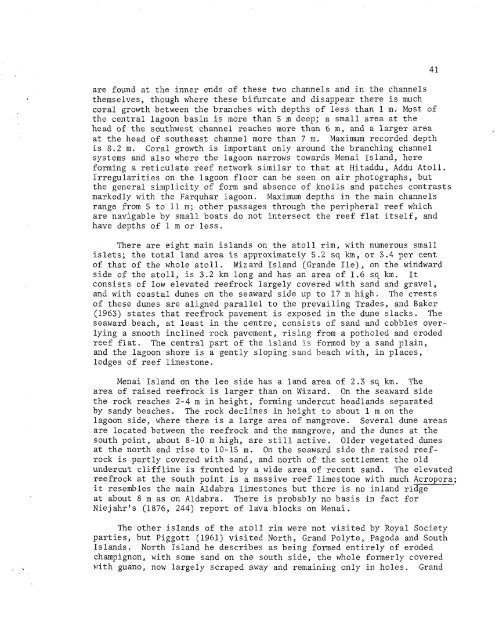ATOLL RESEARCH BULLETIN - Smithsonian Institution
ATOLL RESEARCH BULLETIN - Smithsonian Institution
ATOLL RESEARCH BULLETIN - Smithsonian Institution
You also want an ePaper? Increase the reach of your titles
YUMPU automatically turns print PDFs into web optimized ePapers that Google loves.
are found at the inner ends of these two channels and in the channels<br />
themselves, though where these bifurcate and disappear there is much<br />
coral growth between the branches with depths of less than 1 m. Most of<br />
the central lagoon basin is more than 5 m deep; a small area at the<br />
head of the southwest channel reaches more than 6 m, and a larger area<br />
at the head of southeast channel more than 7 m. Maximum recorded depth<br />
is 8.2 m. Coral growth is important only around the branching channel<br />
systems and also where the lagoon narrows towards Menai Island, here<br />
forming a reticulate reef network similar to that at I-Iitaddu, Addu Atoll.<br />
Irregularities on the lagoon floor can be seen on air photographs, but<br />
the general simplicity of form and absence of knolls and patches contrasts<br />
markedly with the Farquhar lagoon. Maximum depths in the main channels<br />
range from 5 to 11 m; other passages through the peripheral reef which<br />
are navigable by small boats do not intersect the reef flat itself, and<br />
have depths of 1 m or less.<br />
There are eight main islands on the atoll rim, with numerous small<br />
islets; the total land area is approximately 5.2 sq km, or 3.4 per cent<br />
of that of the whole atoll. Wizard Island (Grande Ile), on the windward<br />
side of the atoll, is 3.2 km long and has an area of 1.6 sq km. It<br />
consists of low elevated reefrock largely covered with sand and gravel,<br />
and with coastal dunes on the seaward side up to 17 m high. The crests<br />
of these dunes are aligned parallel to the prevailing Trades, and Baker<br />
(1963) states that reefrock pavement is exposed in the dune slacks. The<br />
seaward beach, at least in the centre, consists of sand and cobbles over-<br />
lying a smooth inclined rock pavement, rising from a potholed and eroded<br />
reef flat. The central part of the island is formed by a sand plain,<br />
and the lagoon shore is a gently sloping sand beach with, in places,<br />
ledges of reef limestone.<br />
Menai Island on the lee side has a land area of 2.3 sq km. The<br />
area of raised reefrock is larger than on Wizard. On the seaward side<br />
the rock reaches 2-4 m in height, forming undercut headlands separated<br />
by sandy beaches. The rock declines in height to about 1 m on the<br />
lagoon side, where there is a large area of mangrove. Several dune areas<br />
are located between the reefrock and the mangrove, and the dunes at the<br />
south point, about 8-10 m high, are still. active. Older vegetated dunes<br />
at the north end rise to 10-15 m. On the seaward side the raised reef-<br />
rock is partly covered with sand, and north of the settlement the old<br />
undercut cliffline is fronted by a wide area of recent sand. The elevated<br />
reefrock at the south point is a massive reef limestone with much Acropora;<br />
it resembles the main Aldabra limestones but there is no inland ridge<br />
at about 8 m as on Aldabra. There is probably no basis in fact for<br />
Niejahr's (1876, 244) report of lava blocks on Menai.<br />
The other islands of the atoll rim were not visited by Royal Society<br />
parties, but Piggott (1961) visited North, Grand Polyte, Pagoda and South<br />
Islands. North Island he describes as being formed entirely of eroded<br />
champignon, with some sand on the south side, the whole formerly covered<br />
with guano, now largely scraped away and remaining only in holes. Grand

















